The RSI is a staple indicator of the technical analysis community but how good is it, really? What are the best settings? What does its trade profile look like? Ask around and no one can tell you… Does it not seem strange that so many traders can be using an indicator without solid data on its performance? Well we are on a mission to change that. We tested 3800 different RSI settings through 300 years of data across 16 different global markets~ to reveal the facts.
Download A FREE Spreadsheet With Data, Charts
And Results For all 3,800 RSIs Tested
.
RSI – Test Results:
.
- Our Testing Strategy Explained
- ANY, Range = 1
- ANY > 0, Range = 1, 2, 3, 4, 5
- ENTRY > 0, Range = 1, 2, 3, 4, 5
.
Our Testing Strategy Explained
noʊtɑ bɛnɛ (Note Well) we use an EMA when calculating the RSI instead of a WS-MA. This is not just to be difficult, please read more about the RSI for an explanation. The formula to convert the EMA Look Back period to the identical equivalent WS-MA used by your charting programs when calculating the RSI is (Period + 1)/2. Below is a table with all the Look Back Periods we tested and how they convert to the original RSI:

Now there are many different ways that signals can be taken from the RSI but to start with we wanted to see how the market behaved when the RSI was in different ‘zones’. We also wanted to find out which RSI Look Back period is the most desirable. But this presents a problem because changing the Look Back period alters the range of an RSI.
For instance during our tests across 16 different markets and 300 years of data the range for the RSI(5) was 89.96 – 10.04 while for the RSI(100) it was 70.77 – 29.23. Clearly a direct level comparison between two RSIs of different look back periods is not suitable.
To overcome this challenge we identified the range for each RSI across all different look back periods tested. Then divided each range by 10 and advanced from the mid line (50) in 1/10th increments specific for each different RSI. The normalisations were numbered based on how many 1/10th of their range they were from 50 (with the exception of the final increment at each end which was extended to 100 or 0 respectively).
Here is a table of the normalisations used which will hopefully clarify:
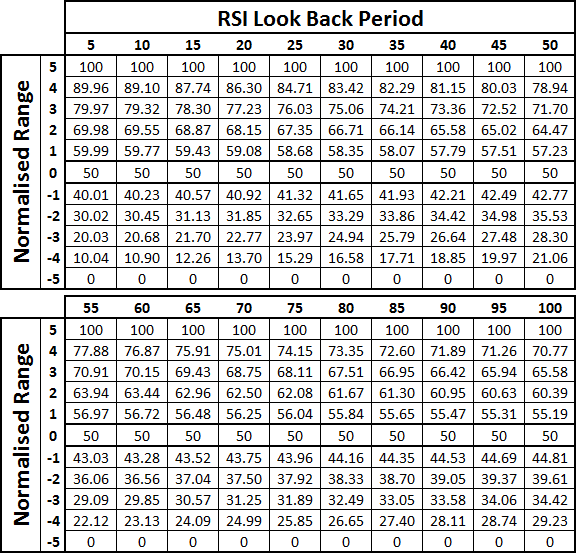
For instance, lets say we wanted to see how the market performed within a 0 – 3 Normalised RSI range on a RSI(15) vs. an RSI(55). Using the table above as a guide we would test the RSI(15) from 50 – 78.30 and the RSI(55) from 50 – 70.91; in doing so we should be comparing apples with apples.
Next it was necessary to exclude some data because it was taken from a sample too small to be conclusive. Lets say you were to buy every time that an RSI(35) was in the -4 to -5 RSI range, in our tests your annualized return during exposure was 248377165801.21%… sounds great right? Yes and no; the average trade did return 1.16% per day… but the average trade duration was only 1 day and you would have only been exposed to the market 3 days a year. Statistics like this are invalid so we excluded anything that didn’t result in market exposure of at least 6%.
We tested all combinations of increment ranges:
Range of 1 = -5 to -4, -4 to -3 … 3 to 4, 4 to 5
Range of 2 = -5 to -3, -4 to -2 … 2 to 4, 3 to 5
Range of 3 = -5 to -2, -4 to -1 … 1 to 4, 2 to 5
Range of 4 = -5 to -1, -4 to -0 … 1 to 4, 2 to 5
Range of 5 = -5 to 0, -4 to 1 … -1 to 4, 0 to 5
The key findings are published below, to see all the results download the full results spreadsheet.
.
RSI: ANY, Range = 1
First, to see how the market behaved in each increment; a long position was taken ANY time the test market was in the corresponding RSI range:
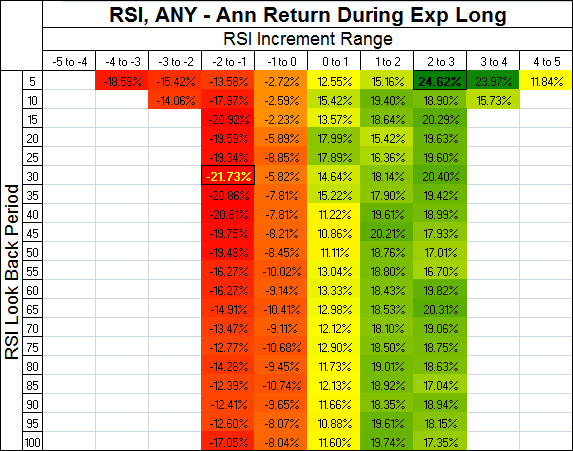
Above 0 (50 on the RSI) and the returns are positive, below zero and the returns were negative, you don’t often see such a clear edge over the market as that (see the results when going Short). The blank cells, (if you were wondering) are where data was excluded because the market exposure < 6%.
.
RSI: ANY > 0, Range = 1, 2, 3, 4, 5
So we now know that RSI > 50 = Good and RSI < 50 = Bad. Lets now look at how far above 50 (the 0 increment) we can go and capture the best profits. A Long position was open ANY time the test market was in the corresponding RSI range:
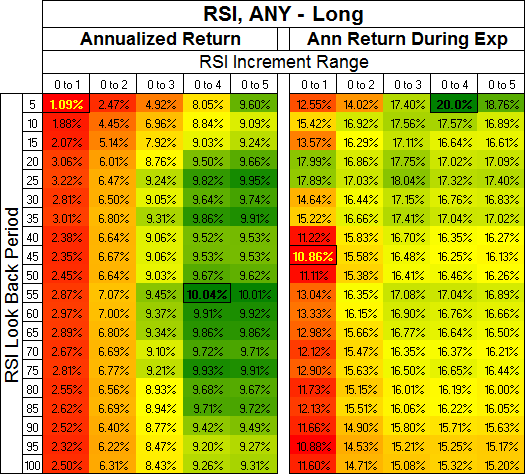
From the above table we can see that the most gains on the Long side occur when the RSI is between the 0 and 4 increment (see results going short). The Look Back period makes surprisingly little difference although around 55 days we see the most gains captured over all:
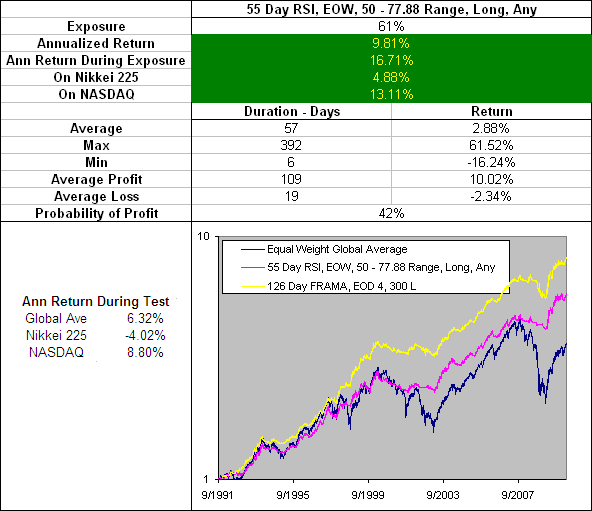
Above are the results from an RSI(55) with a open Long position any time that the RSI was in in the 50 – 77.88 range (0 – 4 increment). The positions were only opened and closed at the End Of the Week (EOW) because switching from EOD to EOW almost doubled the average trade duration and the probability of profit (see the results EOD). While the trade profile is quite good, the MA Crossover or FRAMA are still both more desirable.
Note – our RSI(55) using an EMA is equivalent to an RSI(28) in your charting programs which use Wilder’s Smoothing.
.
RSI, ENTRY > 0, Range = 1, 2, 3, 4, 5
What if we only opened a Long position when the RSI was rising? In these tests a position was only initiated when the RSI went from being below 50 (the 0 increment) to above 50. It was then held as long as the RSI remained in the corresponding range:
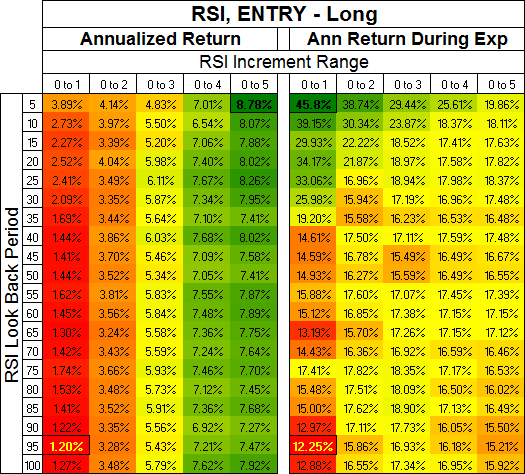
By introducing entry criteria to the RSI trades the market exposure decreased and with it the returns in most areas (see results going short). One area that does stands out however; the Annualized Return During Exposure when the RSI(5) moves through the 0 – 1 increment. Lets take a look at the trade profile:

Above are the results from an RSI(5) with a position opened Long only when the RSI raised above 50. The position was then held until the RSI moved above 55.99 or back below 50 (the 0 – 1 increment). The resulting trade profile doesn’t suit my style but I will entertain the idea because it may suit yours…
You don’t have to look far in the quant blogosphere to find examples of systems based on holding a position for only one day following an fed announcement when the VIX is above a certain level etc. Anyway, be this a practical system or not, it does have a rather smooth looking equity curve and a high probability of profit. Just for fun, lets look at what happens if we add 4X leverage and only go Long when the 13 / 48 MA Crossover is confirming the RSI signal:
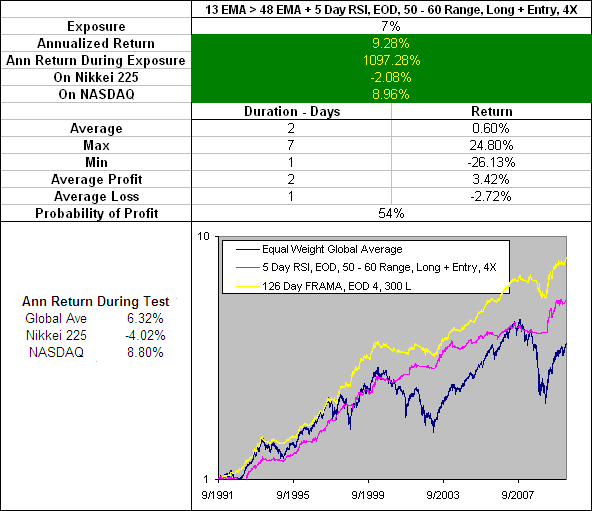
You must admit, once you crank up the leverage and remove the bear markets by confirming the signals with the 13 / 48 MA Crossover; this is an impressive looking equity curve. The best part is that you are only exposed to the market 7% of the time! Realistic in the real market? Questionable…
Perhaps with the use of futures this could be a workable strategy. It was profitable on 15/16 global indices we tested and showed a 54% probability of profit through 3837 trades (a nice large sample). What do you think?
.
RSI Conclusion
Never before have I seen such a dichotomy of profitable and unprofitable trades when an indicator is above or below a level as is the case with the RSI being above or below 50. This proves that momentum is a strong and valuable predictor of market direction and the theory behind the RSI is sound. For this reason it would be worth testing your system with entry signals confirmed by the RSI(55) being on the appropriate side of 50. (Remember to use the conversion table; our RSI(55) will be an RSI(28) in your charting program.)
While the RSI clearly provides valuable information, unfortunately we are yet to identify a method of use that presents a more desirable trade profile than the simple effectiveness of the MA Crossover or the FRAMA.
We also tried using an EMA signal line on the RSI but the results where not worth writing about (download all the results in a spreadsheet to see for yourself.) However I feel that there will be other worthwhile ways to test the RSI. Perhaps it could be used as a breadth indicator where the number of higher highs from the RSI is compared to the number of higher highs from the stocks within an ETF?
How would you like to see the RSI tested? Ideas?
More in this series:
We have conducted and continue to conduct extensive tests on a variety of technical indicators. See how they perform and which reveal themselves as the best in the Technical Indicator Fight for Supremacy.
- ~The data used for these tests is included in the results spreadsheet and more details about our methodology can be found here.
- No interest was earned while in cash and no allowance has been made for transaction costs or slippage. Trades were tested using End Of Day (EOD) signals on Daily data except where otherwise noted.